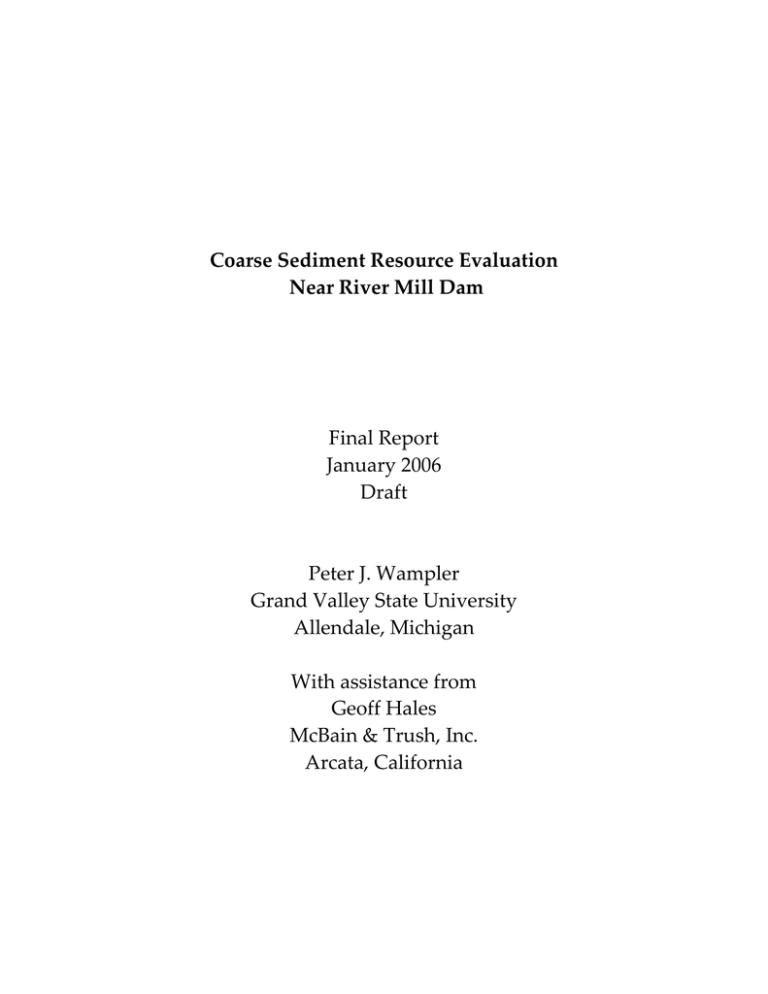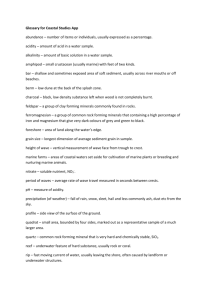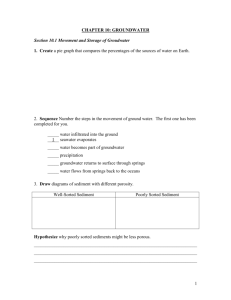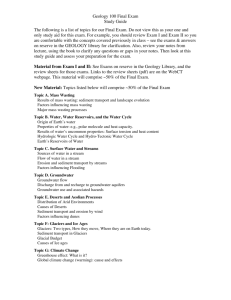Final Report January 2006 Draft
advertisement

Coarse Sediment Resource Evaluation Near River Mill Dam Final Report January 2006 Draft Peter J. Wampler Grand Valley State University Allendale, Michigan With assistance from Geoff Hales McBain & Trush, Inc. Arcata, California Executive Summary The Coarse Sediment Augmentation Plan for the lower Clackamas River below River Mill Dam and in the Oak Grove Fork below Lake Harriet Dam will require large quantities of coarse sediment. One of the potential resources identified for this purpose is the Portland General Electric (PGE) land adjacent to River Mill Dam on the north side of the Clackamas River. This deposit is located on the same terrace being mined by Estacada Rock Products Inc., west of the dam. It is has been assumed, based on geologic correlation, that the terrace near River Mill Dam is similar in grain‐size and thickness to the Estacada Rock Products’ exposure. Five bulk samples were obtained and analyzed to verify both this assumption, and to quantify the total volume and grain‐size distribution of the deposit. The terrace deposit contains roughly 27 years of proven resource, and 55 years of probable resource based on sampling to‐date and an assumed introduction rate of 7,646 m3/year (10,000 yd3/year). Annual average introduction for the life of the project will likely be lower than this amount. About 65% of the deposit consists of gravel‐size material between 2 and 177 mm. The deposit is relatively “clean” with an average of only 2.1% silt‐size and smaller material. The lower depth limit of the deposit was not reached in any of the test pits; however, it is likely that the deposit extends well below the depth sampled. Groundwater was encountered in all the test pits. The groundwater table and the potential for water in the mining area will need to be incorporated into the mining plan that is developed for this site. Cold groundwater from the terrace may provide an important source of cold water for temperature mitigation below River Mill Dam. The groundwater encountered during the excavation of test pits at the site was uniformly cold (~ 11‐12 C) and could be used to lower river temperatures in the summer. Significant additional data would be needed to evaluate this possibility. Additional information about the volume of groundwater and the groundwater aquifer could be obtained using seismic or ground‐penetrating radar techniques, installing monitoring wells, and performing pump tests of the wells. i Introduction The goal of materials sampling was to better understand the extent and grain‐ size distribution of coarse sediment resource planned for use in the Coarse Sediment Augmentation Plan for the lower Clackamas River near River Mill Dam and potentially the Oak Grove Fork below Harriet Dam. The resource evaluation was accomplished using an excavator, dump truck, mobile sieve screen, and loader to collect bulk samples for analysis. Sampling took place between August 1 and 5, 2005. Grain‐size and volume data allow predictions of the life of the deposit given the anticipated augmentation rate. Grain‐size data also provides decision makers with information to evaluate whether screening of large boulders or fine silt is needed prior to placement adjacent to the river. Groundwater and deposit depth data, acquired during the sampling, provide sufficient detail to make preliminary recommendations for a mining plan. The course sediment introduction site, adjacent to the river, was also surveyed and evaluated to determine the work needed to prepare a place for augmented coarse sediment to be entrained by the river during high flows. Materials sampling was coordinated with Chip Oetting, an archeaologist hired by PGE, to ensure that data collection protected existing cultural resources. Sample sites were spaced to characterize the available resource within the limitations imposed by known and potential cultural resources. Chip Oetting was present during excavation to make observations of any cultural items found. Methods Five test pits were excavated to the maximum depth possible with the available excavator which was approximately 6 m (20 feet) (Figure 1). Three additional sites were targeted for excavation on the land owned by PGE to the west; however, these sites had not undergone cultural resource evaluation prior to the sampling period and therefore were not sampled. Each test pit was photographed and described. Mapping sedimentary stratigraphy below the top meter of the test pit was not possible due to safety concerns (wall collapse). 1 Figure 1. Location map for test pits and coarse sediment resources. The dashed line is the cross‐section depicted in Figure 3. A bulk sample from each test pit was loaded into a pre‐weighed dump truck and a total sample weight was obtained at the Estacada Rock Products truck scale. The sample was dumped in a concrete barrier enclosure (to prevent sample loss) and conveyed with a loader to a Viper mobile screening plant where the sample was separated into two populations: “minus 127 mm” and “plus 127 mm”. Rocks less than approximately 127 mm (5 inches) passed through the vibrating screen and onto a conveyor belt. This material was conveyed into the empty dump truck and then weighed at Estacada Rock Products. Subtracting the minus 127 weight from the total sample weight allowed determination of the plus 127‐ mm (5‐inch) fraction (Table 1). The plus 127‐mm rocks passed over the Viper screen and were collected in a pile for separate grain‐size analysis. The two fractions of each sample were retained in piles near the screening location (Figure 2). Next, material from the plus and minus 127‐mm populations was sampled to determine the grain‐size distribution. For the minus 127‐mm population of each sample, a representative sub‐sample was placed in woven poly bags and transported to Kleinfelder, Inc., a materials lab in Portland. The sample size for 2 Table 1. Field weights of bulk samples. Sample # Date MS‐4 Truck + Sample Sample Wt. Truck + < 5ʺ < 5ʺ Sample Wt. > 5ʺ Sample Wt. Wt. sent to Lab (tons) (lbs) (lbs) (kg) (tons) (lbs) (lbs) (kg) (lbs) (kg) (lb) (kg) 8/2/2005 30 60,400 37,480 17,001 26 52,420 29,500 13,381 7,980 3,620 644 292 MS‐5 8/3/2005 30 60,760 37,840 17,164 26 51,360 28,440 12,900 9,400 4,264 612 278 MS‐6 8/3/2005 30 60,800 37,880 17,182 27 54,440 31,520 14,297 6,360 2,885 620 281 MS‐7 8/2/2005 28 56,360 33,440 15,168 24 47,920 25,000 11,340 8,440 3,828 651 295 MS‐11 8/2/2005 29 58,480 35,560 16,130 27 53,000 30,080 13,644 5,480 2,486 628 285 36,440 16,529 28,908 13,112 7,532 3,416 631 286 Average Figure 2. Plus and minus 127‐mm (5–inch) sample fractions (minus 127 mm on the left and plus 127 mm on the right). the sub‐sample was chosen so that the largest clast in the sample represented less than 1% of the total sample weight, or approximately 290 kg (Church et al., 1987). A set of 26 sieves were used to determine the grain‐size distribution of the sub‐ sample. The smallest sieve was 200‐mesh with an opening size of 0.07 mm. This size is close to the boundary between fine sand and silt (0.063 mm). Material smaller than 0.07 mm (passing the 200‐mesh sieve) was captured and weighed, but no further analysis was done on this portion of the sample. 3 For the plus 127‐mm population, approximately 200 rocks from each sample were measured on site using a gravelometer to determine the grain‐size distribution of the larger rocks. Results The depth of each test pit was measured prior to backfilling, and test pit sites were surveyed using RTK GPS (Table 2). The lower depth limit of the deposit (underlying bedrock) was not reached in any of the test pits. Water was encountered in all the test pits at 3 ‐ 5 m (11 ‐ 17 ft) below the surface. Table 2. Test pit location and depth data. 1 1 Sample # Easting MS‐4 7726485.940 602139.881 434.216 7726357.770 7725674.605 7726013.990 7725865.855 7725285.300 601843.910 601788.780 601962.951 601734.860 601453.100 434.400 427.846 433.375 429.603 356.140 3 MS‐5 MS‐6 MS‐7 MS‐11 Bedrock Northing Elevation 2 Total Total Depth Elevation of Water Elevation of Depth (ft) (m) Depth (ft) Water Table (ft) BOH2(ft) 18 5.5 416.2 14 420.2 18 18 19 20 N/A 5.5 5.5 5.8 6.1 N/A 416.4 409.8 414.4 409.6 N/A 15 14 11 17 N/A 419.4 413.8 422.4 412.6 N/A 1 Oregon State Plane Coordinates in survey feet (NAD83). NGVD88 vertical datum. 3 Not surveyed by the RTK survey. Coordinates estimated from Aerial Photo and Handheld GPS data. 2 The elevation of a single contact between the terrace gravel and the underlying bedrock was observed in a road cut below the terrace (Table 2). This contact was surveyed with the assumption that the exposure might represent the base elevation of the deposit for the entire terrace and could be useful to estimate terrace thickness. The elevation surveyed was 356.14 feet (NGVD88). However, an alternative interpretation is that that this geologic contact represents a contact between a lower terrace and the bedrock and thus was not used to estimate total thickness for the deposit being evaluated (Figure 3). 4 500 450 Coarse sediment resource ? Elevation (ft NGVD88) 400 350 Water Table ? ? Surveyed contact Clackamas R. Sardine Formation 300 250 200 150 100 0 500 1000 1500 2000 2500 Distance along section (ft) Figure 3. Geologic cross‐section through the coarse sediment resource. The approximate cross‐section location is shown on Figure 1. Minus 127‐mm (5‐inch) Sub‐sample The grain size of the Holocene terrace deposit, evaluated by the five bulk samples, is remarkably uniform. All five samples could be classified as very poorly sorted by the Folk and Ward Method (Folk and Ward, 1957), meaning that there is a broad range of particle sizes centered about the median grain diameter. Median grain diameter (D50) is between 28 and 40 mm (Figure 4). 5 3000 100% 90% 80% Cumulative Percent Finer MS‐4 (D50 = 27.6 mm) 70% MS‐5 (D50 = 33.8 mm) MS‐6 (D50 = 40.9 mm) 60% MS‐7 (D50 = 24.9 mm) MS‐11 (D50 = 26.3 mm) 50% 40% 30% 20% 10% 0% 0.01 0.1 1 10 Grain Size (mm) 100 1000 Figure 4. Cumulative grain size distribution for the minus 127‐mm (5‐inch) fraction. Bulk samples were dominated by the gravel‐size fraction (2 ‐ 64 mm) (Table 3). The amount of silt‐size and smaller sediment ranged from 1.6 to 4.8%. Plus 127‐mm (5‐Inch) Sub‐sample The maximum grain size (Dmax) observed from the material not passing through the Viper screen was 362 mm (14 inches). Gravelometer grain‐size analysis of clasts larger than 127 mm (5 inches) indicates that this fraction is also quite uniform in size, with a mean grain size of 128 mm and a median grain size (D50) of 97 to 108 mm for all samples (Table 4). 6 Table 3. Percentages, by weight, of Wentworth grain sizes in minus 127‐mm (5‐ inch) bulk samples (Wentworth, 1922 and Udden, 1914). Wentworth Size Very coarse gravel (32‐64 mm) Coarse gravel (16‐32 mm) Medium gravel (8‐16 mm) Fine gravel (4‐8 mm) Very fine gravel (2‐4 mm) GRAVEL TOTAL Very coarse sand (1‐2 mm) Coarse sand (0.5‐1 mm) Medium sand (250‐500 microns) Fine sand (125‐250 microns) Very fine sand (63‐125 microns) SAND TOTAL Silt and clay(< 63 microns) MS‐4 47.0% 12.6% 9.3% 5.5% 3.1% MS‐5 51.7% 17.2% 11.5% 6.5% 2.0% MS‐6 55.7% 12.0% 7.8% 4.7% 3.5% MS‐7 46.0% 11.5% 11.3% 8.3% 4.3% MS‐11 Average 46.1% 49.3% 12.5% 13.2% 8.4% 9.7% 6.7% 6.3% 6.5% 3.9% 77.5% 88.9% 83.7% 81.4% 80.2% 82.3% 3.7% 6.7% 5.1% 2.6% 1.4% 2.0% 3.0% 2.3% 1.5% 0.7% 3.4% 4.4% 3.7% 2.1% 1.0% 4.0% 3.6% 3.0% 2.1% 1.1% 5.3% 5.8% 3.4% 1.8% 1.1% 3.7% 4.7% 3.5% 2.0% 1.1% 19.5% 9.5% 14.5% 13.8% 17.4% 15.0% 3.0% 1.6% 1.8% 4.8% 2.4% 2.7% Table 4. Percentage, by number, for the plus 127‐mm (5‐inch) gravelometer data. Phi Size Size (mm) ‐9 ‐8.5 ‐8 ‐7.5 ‐7 ‐6.5 ‐6 ‐5.5 512 362 256 181 128 91 64 45 D50 (mm) Size (in) 20.16 14.25 10.08 7.13 5.04 3.56 1.00 1.78 MS‐4 0% 1% 1% 16% 51% 31% 1% 0% 103 Percent by Sample Number MS‐5 MS‐6 MS‐7 0% 0% 0% 0% 0% 0% 4% 1% 8% 19% 14% 20% 52% 44% 40% 24% 37% 32% 1% 3% 1% 0% 0% 0% 108 97 108 MS‐11 0% 0% 3% 14% 46% 36% 0% 0% 101 When the data from the plus and minus 127‐mm (5‐inch) fractions are combined, the distribution of the entire bulk samples can be obtained. Bulk samples were dominated by the gravel‐size fraction (Table 5). 7 Table 5. Combined data from plus and minus fractions. Sample # MS‐4 MS‐5 MS‐6 MS‐7 MS‐11 Average % Cobble/Boulder (> 127 mm) 21.3% 24.8% 16.8% 25.2% 15.4% 20.7% % Gravel/Cobble (2 to 127 mm) 61.0% 66.8% 69.6% 60.9% 67.8% 65.2% % Sand (0.063 to 2 mm) 15.3% 7.2% 12.1% 10.3% 14.7% 11.9% % Silt (< 0.063 mm) 2.4% 1.2% 1.5% 3.6% 2.1% 2.1% Available Sediment Volume Two areas are available for mining coarse sediment on PGE property. Each of these areas is approximately 4 hectacres (10 acres) (Figure 1). The eastern area has been adequately evaluated to a depth of 6 m (20 ft) and the sediment volume estimates are well characterized. No bulk samples have been obtained from the 4 hectares (10 acres) to the west. This area has probable coarse sediment resources roughly comparable to the material already sampled. On this portion of the site, either geophysical methods or additional samples should be obtained to verify the resources and similarity of the material. All geologic evidence collected to‐ date suggests that the deposit continues with comparable thickness and grain size. In the eastern sample area, course sediment was overlain by silt and sand that ranged in thickness from 0.5 to 1.4 m (sample site MS‐5 had a thickness of 2 m, but this area was disturbed by clearing and grading activity). If this cover material (often termed “overburden” by miners) is assumed to have a thickness of 1 m for the entire deposit, a total of approximately 12,335 m3 (16,133 yd3) of overburden will be generated by mining the initial 4 hectares (10 acres), and a total of 24,670 m3 (32,267 yd3) will be generated if all probable reserves are cleared of overburden (Table 6). If a gravel thickness of approximately 6 m is assumed for the entire deposit (the deposit likely extends to a depth of 10 ‐ 15 m), and the area effectively sampled by the test pits is approximately 4 hectares (10 acres), the total amount of resource available for extraction is 209,694 m3 (274,270 yd3) (Table 6). This volume is an in‐place volume. The amount actually loaded into trucks or conveyed into the river will be larger due to expansion during mining (the 8 Table 6. Summary of coarse sediment resource volumes 2 Area Primary resource evaluated August 2005 Probable resource not yet evaluated Total Probable available resource Area (acres) Hectares Area (ft2) 1 ft3 yd3 Cubic yards of different size fractions Cobble/Boulder Gravel/Cobble Sand Silt/Clay Overburden 10 4.047 435,600 7,405,200 274,267 56,813 178,909 32,715 5,830 10 4.047 435,600 7,405,200 274,267 56,813 178,909 32,715 5,830 16,133 20 8.094 871,200 14,810,400 548,533 113,626 357,817 65,430 11,660 27.4 5.7 17.9 54.9 11.4 35.8 3.3 6.5 0.6 1.2 3 Years of evaluated resource at 10,000 yd /year Years of probable resource at 10,000 yd3/year 1 Volumes are based on a recoverable gravel thickness of 17 feet and an overbuden thickness of 3 feet. 2 Cobble/Boulder > 127 mm; Gravel/Cobble 2‐127 mm; Sand (.063‐2 mm); Silt/Clay (<.063 mm) 16,133 32,267 density or “packing” of the gravels would likely result in a roughly 10% increase in the available volume). If the additional 4 hectares (10 acres) to the west is included as a probable resource, the total available resource is approximately 419,381 m3 (548,530 yd3). At an introduction rate of 7,646 m3/year (10,000 yd3/year), this would provide probable resources for augmentation for over 50 years. If thicker mineable resources are assumed, the amount of mineable coarse sediment may be over 100 years (Table 7). Table 7. Coarse sediment volumes based on 17‐ and 37‐foot gravel thickness with 10 and 20 acres of mineable area. Resource area Primary 10 acres Primary + Probable 10 acres Gravel thickness Available Available Years of available (minus overburden) material (ft3) material (yd3) resource at 10k yds/yr (ft) 17 7,405,200 274,267 27 37 14,810,400 548,533 55 17 14,810,400 548,533 55 37 29,620,800 1,097,067 110 Augmentation Site Characterization Total station surveying was done on the proposed introduction site; however, vegetation and time constraints did not allow full surveying of the area where materials are to be placed. Prior to final augmentation implementation, a detailed survey of this portion of the river will be needed. The introduction location is characterized by a thin (0‐0.5 m) layer of coarse alluvium with an average grain size of 128 ‐ 362 mm. Bedrock, exposed in several locations, consists of Sardine Formation volcanic breccia with large rock 9 fragments up to 1 m embedded in the bedrock. In order to place augmentation material, it may be necessary to blast or otherwise remove the surface irregularity to facilitate mobilization of augmentation gravel. Alternatively, it may be possible to increase the initial augmentation volume to fill in the holes and cover the large embedded boulders. Recommendation and Conclusions The maximum amount of coarse sediment available depends on the assumptions that are made regarding the mining plan and the feasibility of mining below the water table. It appears, given reasonable assumptions regarding depth and continuity of the deposit, that sufficient resource is available to provide augmentation sediment for the anticipated life of the Clackamas project license. However, the total thickness of the deposit and the potential for off‐site impacts which might result from mining below the groundwater table remain significant unknowns. Also unknown at this time, is the extent and nature of the cultural resources and modifications to the mining plan that may be necessary to protect them. The elevation of the groundwater table in the test pits was quite variable. This suggests local perching of groundwater on bedrock or the presence of paleochannels cut into the bedrock below the sediment. The groundwater at the site is a potential source of uniformly cold water (~ 11‐12 C) which could be used to lower river temperatures in the summer if sufficient recharge is provided in the winter. If additional information about the volume of available groundwater and the nature of the groundwater aquifer is desired, seismic or ground‐penetrating radar techniques could be used. Estacada Rock Products excavates adjacent to this site below the water table by dewatering an excavation area into a mined‐out pond. It is also feasible to mine the site wet (without dewatering), which may in fact be preferable if fines (silt, sand, and clay) are an issue. Mining wet usually results in some of the fine silt and mud washing from the material as it is extracted. I recommend mining the site wet using an excavator and truck to haul the material to a storage pile where it can be conveyed to the augmentation site with a truck or conveyor system. All overburden removed from the surface of the deposit should be retained for use in reclamation of the site. If the overburden is 10 stored along the northern border of the site, it could be revegetated to provide a visual and acoustic screen. Given the depth of the groundwater along with a mining depth of approximately 20 feet below present grade, it is likely that post‐mining land use would include a water feature, such as a pond or constructed wetland. A conceptual mining and reclamation plan would include sequential mining and reclamation as mining progresses (Figure 5). This would result in a pond which could be enhanced for waterfowl or other wildlife and may be eligible for wetland mitigation credit (Figure 6). Recommendations for further work include: • Installation of monitoring wells with piezometers to monitor groundwater temperature and groundwater levels. • Seismic or ground penetrating radar techniques could be used if additional information about the volume of groundwater available and the nature of the groundwater aquifer is desired. • Detailed topographic surveying of the augmentation location prior to leaf out in the spring. • Development of a site‐specific reclamation and mining plan. • Submission of a letter to DOGAMI explaining the proposed plan to solicit a response regarding whether an operating permit will be required for the proposed activity. 11 Figure 5. Hypothetical site mined first as a dry site, but as mining proceeds into the southern segments, the water table is penetrated. (Norman et al., 1996). Figure 6. Final reclamation map of the site in Figure 5 (Norman et al., 1996). 12 References Church, M.A., McLean, D.G., and Wolcott, J.F., 1987, River Bed Gravels: Sampling and Analysis, in Thorne, C.R., Bathurst, J.C., and Hey, R.D., eds., Sediment transport in gravel‐bed rivers, John Wiley & Sons Ltd., p. 43‐87. Folk, R.L. and Ward, W.C., 1957, Brazos River bar: a study in the significance of grain size parameters. Journal of Sedimentary Petrology, 27, 3‐26. Norman, D.K., Wampler, P.J., Throop, A.H., Schnitzer, E.F., and Roloff, J.M., 1996, Best management practices for reclaiming surface mines in Washington and Oregon, Portland, OR, Oregon Department of Geology and Mineral Industries, variously paginated. Udden, J.A., 1914, Mechanical composition of clastic sediments. Bulletin of the Geological Society of America, 25, 655‐744. Wentworth, C.K., 1922, A scale of grade and class terms for clastic sediments. Journal of Geology, 30, 377‐392. 13






